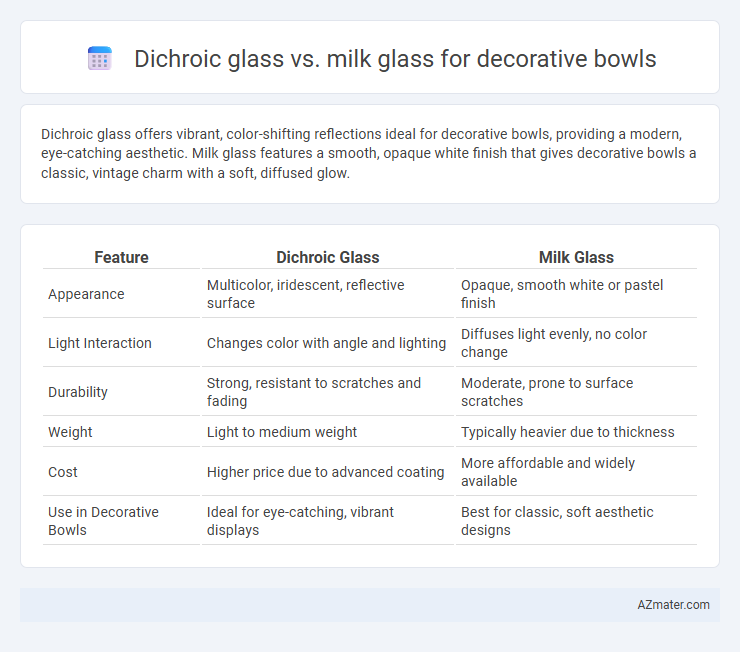Dichroic glass offers vibrant, color-shifting reflections ideal for decorative bowls, providing a modern, eye-catching aesthetic. Milk glass features a smooth, opaque white finish that gives decorative bowls a classic, vintage charm with a soft, diffused glow.
Table of Comparison
| Feature | Dichroic Glass | Milk Glass |
|---|---|---|
| Appearance | Multicolor, iridescent, reflective surface | Opaque, smooth white or pastel finish |
| Light Interaction | Changes color with angle and lighting | Diffuses light evenly, no color change |
| Durability | Strong, resistant to scratches and fading | Moderate, prone to surface scratches |
| Weight | Light to medium weight | Typically heavier due to thickness |
| Cost | Higher price due to advanced coating | More affordable and widely available |
| Use in Decorative Bowls | Ideal for eye-catching, vibrant displays | Best for classic, soft aesthetic designs |
Introduction to Dichroic and Milk Glass
Dichroic glass features a multi-layered coating that reflects and transmits different wavelengths of light, creating vibrant color shifts and a dynamic visual effect ideal for decorative bowls. Milk glass, characterized by its opaque, white, or colored glass with a smooth, glossy finish, offers a classic, elegant appearance that contrasts with its translucent counterparts. Both materials provide unique aesthetic qualities, with dichroic glass emphasizing brilliance and color variation, while milk glass delivers a timeless, solid look for decorative applications.
Understanding Dichroic Glass: Properties and Appeal
Dichroic glass features multiple micro-layers of metal oxides, creating vibrant color shifts and reflective qualities that change with the angle of light, making it highly desirable for decorative bowls. Its shimmering, iridescent surface offers a dynamic visual appeal, contrasting with the opaque, smooth, and creamy texture of milk glass, which provides a classic, vintage charm. The unique optical properties of dichroic glass enhance the interplay of light and color, elevating decorative bowl designs with modern sophistication and artistic flair.
What Makes Milk Glass Unique?
Milk glass is unique due to its opaque, milky white appearance created by adding opacifiers like tin or bone ash during production, giving it a smooth, glossy finish ideal for decorative bowls. Unlike dichroic glass, which reflects multiple colors through thin film interference, milk glass offers a vintage, classic look prized for its simplicity and versatility in home decor. Its durability and ability to diffuse light softly make milk glass bowls both functional and aesthetically timeless.
Color and Light Effects: Dichroic vs Milk Glass
Dichroic glass displays vibrant, shifting colors that change with light angles, creating dynamic and reflective effects ideal for decorative bowls. Milk glass offers a soft, opaque white hue that diffuses light gently, providing a classic and subtle glow without color variation. The intense color play in dichroic glass contrasts sharply with the muted, consistent luminosity of milk glass, making each suitable for different aesthetic preferences.
Durability and Maintenance Comparison
Dichroic glass offers superior durability due to its multiple micro-layers of metal oxides, making it resistant to scratches and fading, ideal for decorative bowls exposed to light. Milk glass, while aesthetically pleasing with its opaque finish, is more susceptible to chipping and requires gentle handling to prevent surface damage. Maintenance of dichroic glass involves simple cleaning with mild soap and water, whereas milk glass may need extra care to avoid staining and preserve its glossy appearance over time.
Aesthetic Versatility for Decorative Bowls
Dichroic glass offers vibrant color-shifting properties that enhance aesthetic versatility in decorative bowls, creating dynamic visual effects that change with lighting and viewing angles. Milk glass provides a soft, opaque finish with a timeless elegance, blending easily with various decor styles for a classic or contemporary look. Both materials offer unique design possibilities, but dichroic glass excels in dramatic color interplay, while milk glass emphasizes subtle sophistication.
Pricing and Market Availability
Dichroic glass decorative bowls typically command higher prices due to their complex manufacturing process and vibrant, color-shifting properties, often ranging from $100 to $300 or more per piece. Milk glass bowls are generally more affordable and widely available, with prices usually between $20 and $80, benefiting from mass production and simpler materials. Market availability favors milk glass for budget-conscious consumers and large retail outlets, while dichroic glass is often found in specialty art galleries and high-end boutiques.
Ideal Settings for Dichroic and Milk Glass Bowls
Dichroic glass bowls are ideal for modern, artistic displays where changing light angles enhance their iridescent, multicolor effects, making them perfect for well-lit areas or near windows. Milk glass bowls suit traditional or vintage settings, offering a smooth, opaque finish that complements soft ambient lighting and cozy environments. Both types perform best with accent or spot lighting to highlight the unique textures and visual appeal of each glass style.
Collectors’ Perspectives and Trends
Dichroic glass is prized by collectors for its vibrant, color-shifting properties caused by micro-layered metals, making decorative bowls highly desirable for modern and avant-garde collections. Milk glass, valued for its opaque, milky-white appearance and vintage charm, remains popular among collectors who favor antique and mid-century decorative styles. Trends show a growing interest in dichroic glass bowls among contemporary collectors driven by artistic innovation, while milk glass retains steady appeal due to nostalgia and classic design aesthetics.
Final Thoughts: Choosing the Right Glass for Decorative Bowls
Dichroic glass offers vibrant color shifts and light-reflective properties ideal for eye-catching decorative bowls, while milk glass provides a classic, opaque finish with a smooth, matte look suited for timeless elegance. The choice hinges on your decor style: dichroic glass complements modern, dynamic interiors, whereas milk glass fits traditional or vintage aesthetics. Durability and maintenance are comparable, but dichroic glass may require more careful handling due to its layered coatings.

Infographic: Dichroic glass vs Milk glass for Decorative bowl
 azmater.com
azmater.com